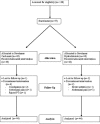Sevelamer carbonate experience in Indian end stage renal disease patients
- PMID: 23087553
- PMCID: PMC3459522
- DOI: 10.4103/0971-4065.98754
Sevelamer carbonate experience in Indian end stage renal disease patients
Abstract
This open label, multicentric, comparative clinical trial was done to compare the efficacy and tolerability of two sevelamer formulations, sevelamer carbonate, and sevelamer hydrochloride, in the treatment of hyperphosphatemia in Indian end stage renal disease (ESRD) patients. A total of 97 ESRD patients on hemodialysis, were enrolled. Patients were randomized to receive either sevelamer carbonate or sevelamer hydrochloride. All patients were evaluated every week for 6 weeks for efficacy and safety variables. Total 88 patients completed the study. After 6 weeks of therapy, there were similar reductions (P<0.0001) in mean serum phosphorus and the CaxP product both the groups. The responder rates for test and reference groups were 75%, 68.18% respectively (P=0.3474). The adverse events reported were nausea, abdominal pain/discomfort, heartburn, constipation, diarrhea, increased prothrombin time, and severe arthritis. No serious adverse events were reported. There was no significant difference between the groups for adverse events and the laboratory parameters. From the results of this multicentric, comparative, randomized clinical study on sevelamer carbonate we can recommend that sevelamer carbonate may be used as a phosphate binder in Indian chronic kidney disease patients.
Keywords: Chronic renal failure; end stage renal disease; hyperphosphatemia; sevelamer carbonate; sevelamer hydrochloride.
Conflict of interest statement
Figures
References
-
- Duggal A, Hanus M, Zhorov E, Dagher R, Plone MA, Goldberg J, et al. Novel dosage forms and regimens for sevelamer-based phosphate binders. J Ren Nutr. 2006;16:248–52. - PubMed
-
- Bleyer AJ, Burke SK, Dillon M, Garrett B, Kant KS, Lynch D, et al. A comparison of the calcium-free phosphate binder sevelamer hydrochloride with calcium acetate in the treatment of hyperphosphatemia in hemodialysis patients. Am J Kidney Dis. 1999;33:694–701. - PubMed
-
- Chertow GM, Burke SK, Dillon MA, Slatopolsky E. Long-term effects of sevelamer hydrochloride on the calcium×phosphate product and lipid profile of haemodialysis patients. Nephrol Dial Transplant. 1999;14:2907–14. - PubMed
-
- Slatopolsky EA, Burke SK, Dillon MA. RenaGel. A nonabsorbed calcium..and aluminum.free phosphate binder, lowers serumphosphorus and parathyroid hormone. The RenaGel Study Group. Kidney Int. 1999;55:299–307. - PubMed
-
- Joy MS, Finn WF LAM-302 Study Group. Randomized, double-blind, placebo-controlled, dose-titration, phase III study assessing the efficacy and tolerability of lanthanum carbonate: A new phosphate binder for the treatment of hyperphosphatemia. Am J Kidney Dis. 2003;42:96–107. - PubMed


